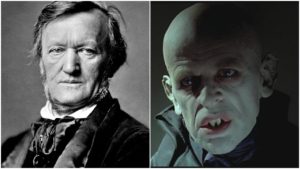
Opera Meets Film: The Narrative & Emotional Nuance of Wagner’s ‘Das Rheingold’ in Herzog’s ‘Nosferatu the Vampyre
By David Salazar“Opera Meets Film” is a feature dedicated to exploring the way that opera has been employed in cinema. We will select a film section or a film in its entirety and highlight the impact that utilizing the operatic form or sections from an opera can alter our perception of a film that we are viewing. This week’s installment features Werner Herzog’s “Nosferatu the Vampyre.”
One of the most iconic moments of Werner Herzog’s remake of Murnau’s 1922 “Nosferatu” comes about 25 minutes in when Harker (played by Bruno Ganz) heads into the wilderness on his way to Count Dracula’s mysterious castle.
At this point in the story, he has already been warned by a group of gypsy of Dracula’s evil, but he ventures on due to his work obligations.
As Harker sits atop a hill completely lost, Herzog introduces the viewer to the opening notes of the prelude to Wagner’s “Das Rheingold.” The iconic E flat major arpeggios slowly build up as Herzog moves day into night and a clear sky to one overrun by clouds.
The effect is immediate and fascinating. While the images grow more sinister, the music grows more lush and hopeful. While most directors might opt for a more obvious choice of music matching the darkened state (in Wagnerian terms, the prelude to “Siegfried” offers up a dark and menacing tone), Herzog’s counterpoint works precisely because it creates an emotional confusion. On one hand, we know intuitively that there is danger on the horizon. The images could not be clearer in this regard. But on the other, the music offers up aspiration and sublime beauty.
But that’s not the only time Wagner’s music plays during “Nosferatu the Vampyre.”
The music makes its appearance on two separate instances, both very closely linked with the first appearance and its thematic implications.
The second time we hear the arpeggios of Wagner’s prelude comes when the captain of the ship on which Dracula is hiding, writes a letter of the mysterious passenger. His letter prefaces Dracula’s eventual murder of all the crew members and his eventual takeover of the ship on his way to Harker’s town.
And it appears yet again over an image of rats on the harbor, infesting the land in broad daylight. The music plays as we cut to an image of the lonely village at night with Dracula leaving the ship, coffin in hand, eventually settling into an abandoned church.
The effect is very similar to the initial introduction of the music – the glorious nature of Wagner’s music counterpoints sinister dealings by Dracula.
So what to make of this counterpoint and what it means for the story? For that, I think it is clear that we can look right at Wagner’s own tetralogy for clues.
Those familiar with the Ring know that this music, as transcendent as it is, is but a tease to what happens in the very first scene of the Ring – we go from this rapture to the theft of the Rheingold by Alberich and the entire conflict of the massive saga is unleashed.
And it can’t be lost on anyone that all three passages in “Nosferatu the Vampyre” feature water imagery around them. As Harper is picked up by a carriage in the dead of night during the first excerpt of the prelude, Herzog zooms in on the river. The captain is writing his letter aboard a ship and the final reference happens right on a dock by a body of water.
And another important connection comes between the Rheingold, the lifeblood of the Rhine river, and its soul-sucking effect on all the characters in Wagner’s tetralogy. No doubt, Herzog had this in mind when he was finding a narrative means of connecting music with a blood-sucking vampire.
So in a way, Herzog’s choice here is not merely sensorial, but also symbolic. Herzog’s directly referencing Wagner’s opus for narrative means: the appearance of this theme will precede not only Dracula himself, but his terrorizing actions on those who are connected with the music. First it’s Harker, who will shortly thereafter be cursed and abandoned by Dracula. The second instance precedes the death of the sailors aboard the ship. And the final excerpt is followed by Dracula (and the rats) terrorizing the town via the plague.
It’s in this unique way that Herzog not only creates a magical emotional effect on the viewer, but provides an intertextual reading of his own film in light of the music he uses and its original work.
Categories
Opera Meets Film

